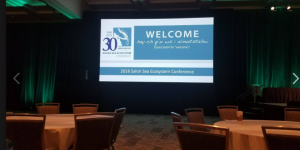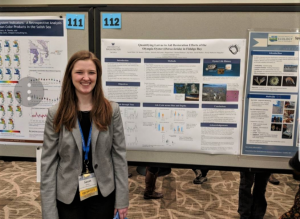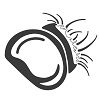 I still remember where I was when I received the text message from Dr. Becker about attending the 2018 Salish Sea Ecosystem conference. I was walking out of class, with less than a week remaining as a college student. Although my experience at UW Tacoma seemed to be coming to a close, little did I know it was only the beginning. I was excited to represent the lab that took me under their wing as an inexperienced student, strengthened my independent research skills, and built amazing connections to last a lifetime. As the conference was getting closer, I was very nervous about presenting in Seattle.
I still remember where I was when I received the text message from Dr. Becker about attending the 2018 Salish Sea Ecosystem conference. I was walking out of class, with less than a week remaining as a college student. Although my experience at UW Tacoma seemed to be coming to a close, little did I know it was only the beginning. I was excited to represent the lab that took me under their wing as an inexperienced student, strengthened my independent research skills, and built amazing connections to last a lifetime. As the conference was getting closer, I was very nervous about presenting in Seattle.
The first day came, and as a Salish Sea volunteer I had already built connections with representatives from Western Washington University, the Dept. of Fish and Wildlife, the Dept. of Natural Resources, the Muckleshoot Tribe, and the list goes on. At the same time, it felt like a fun reunion with the UW Tacoma and MAst Center representatives! One individual that stuck out to me was Jenny, a librarian from Western. As I talked to her about her career before Western, I found out about her thesis at the University of Arizona in microbiology that focused on identifying diseases in groundwater. Between learning about her thesis and the variety of topics discussed at the conference, it taught me two things: One, that there are so many different disciplines in the environmental science field and two, that Bill Nye’s quote is true that ‘everyone you will ever meet knows something you don’t’.
When Governor Jay Inslee gave a speech at the beginning of the conference, it hit me how much of an impact the Salish Sea has on Washington State. It made me understand not only how much work we have left to do, but it also brought us together to celebrate how far we have come. As the sessions began, it was fascinating to be able to pick out which talks you’re interested in, from watershed research to environmental policy panels. I began with talks that were similar to what I was studying, such as marine invertebrate studies and research to prevent pre-spawn mortality. After learning more about the biological aspects of salmon mortality, I went to a talk about gene-based monitoring in Pacific Coast seabirds. My experience in environmental research all began with COASST, an organization at the University of Washington that focuses on identifying the cause of seabird mortality through citizen science. Based on my experience with COASST, it was eye-opening to learn about the gene-modeling based approach to track the rhinoceros auklet and double-crested cormorant species from Washington to California. After the seabirds talk, I changed to a session about agriculture and non-point source water pollution from the Washington State University Puyallup campus. This talk mainly focused on the runoff from agriculture and how it affects nearshore habitats and what restoration approaches will be applied in the future. Since this research was beginning, it was interesting to see their brainstorming ideas on how to get more farmers and citizens involved in habitat restoration. I’ll be curious to see the updates of this study.
 When it was time for my poster session I met people that researched Fidalgo Bay and wanted to learn more about oyster populations. I also met undergrads from Western Washington University that knew the Becker Lab, and I was able to shake hands with the individuals that assisted with our 2013 project. It is one thing to be in the lab hand counting samples, but it is a whole other experience to actually meet the representatives that helped with the life cycle of larvae for our study in 2013! The data analysis from the 2013 hand counts turned some heads as well. One individual noticed the data, and I found out the individual was a graphic designer for a company in Bellevue and was very intrigued by our research. I even met someone from high school! Long story short, I was able to build amazing connections that I wouldn’t have made otherwise. If I do get the chance to go to the next conference, I would definitely attend more of the panel discussions and go out of my comfort zone in terms of disciplines. I would like to share a quote that was at the end of the restoration project talk, given by the Estuary and Salmon Restoration Program that I felt fit well with the goal of the Salish Sea Conference:
When it was time for my poster session I met people that researched Fidalgo Bay and wanted to learn more about oyster populations. I also met undergrads from Western Washington University that knew the Becker Lab, and I was able to shake hands with the individuals that assisted with our 2013 project. It is one thing to be in the lab hand counting samples, but it is a whole other experience to actually meet the representatives that helped with the life cycle of larvae for our study in 2013! The data analysis from the 2013 hand counts turned some heads as well. One individual noticed the data, and I found out the individual was a graphic designer for a company in Bellevue and was very intrigued by our research. I even met someone from high school! Long story short, I was able to build amazing connections that I wouldn’t have made otherwise. If I do get the chance to go to the next conference, I would definitely attend more of the panel discussions and go out of my comfort zone in terms of disciplines. I would like to share a quote that was at the end of the restoration project talk, given by the Estuary and Salmon Restoration Program that I felt fit well with the goal of the Salish Sea Conference:
“There can be no purpose more enspiriting than to begin the age of restoration, reweaving the wondrous diversity of life that still surrounds us… The next century will, I believe, be the era of restoration in ecology.”
-E.O. Wilson, The Diversity of Life
Overall, I give the conference two-thumbs up! This conference and its projects focused on my home state and it reminded me that as Washingtonians we have beautiful scenery to look at daily, and we often take it for granted. I’m motivated to get back to work with a new perspective and to improve the Salish Sea!
